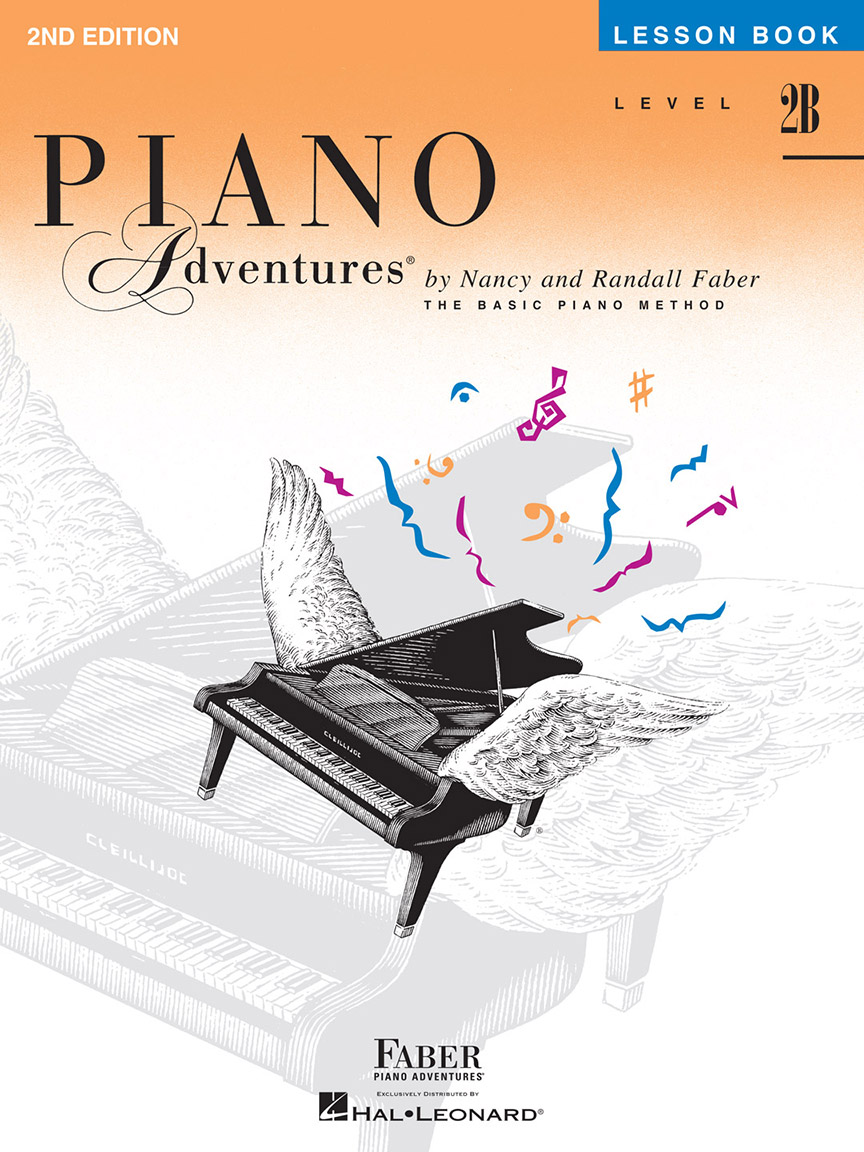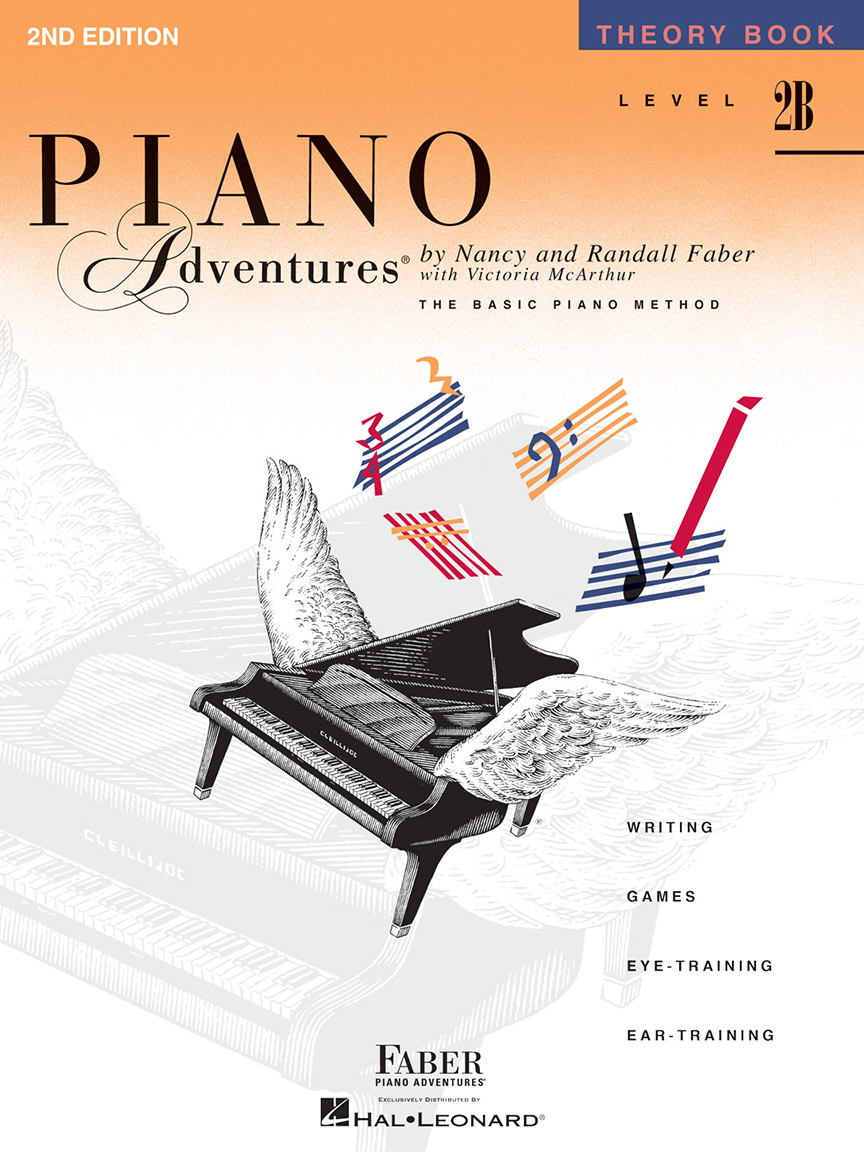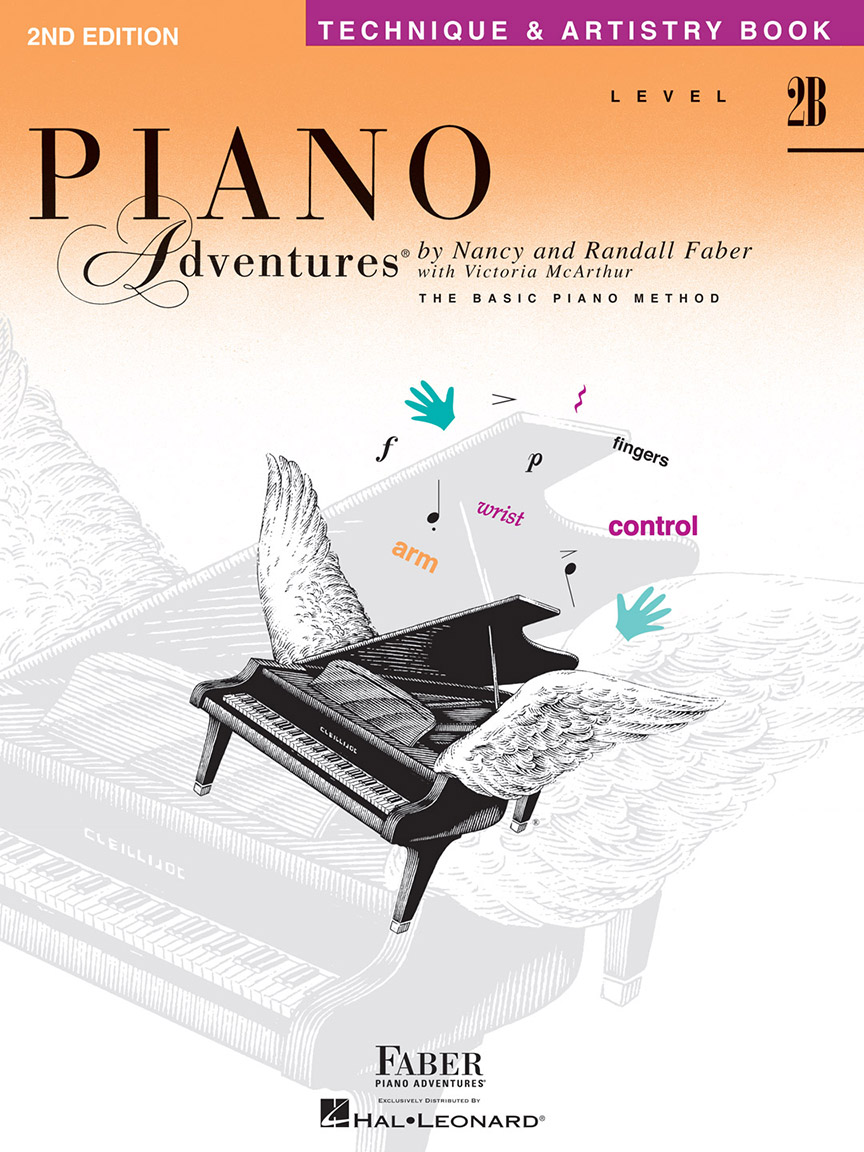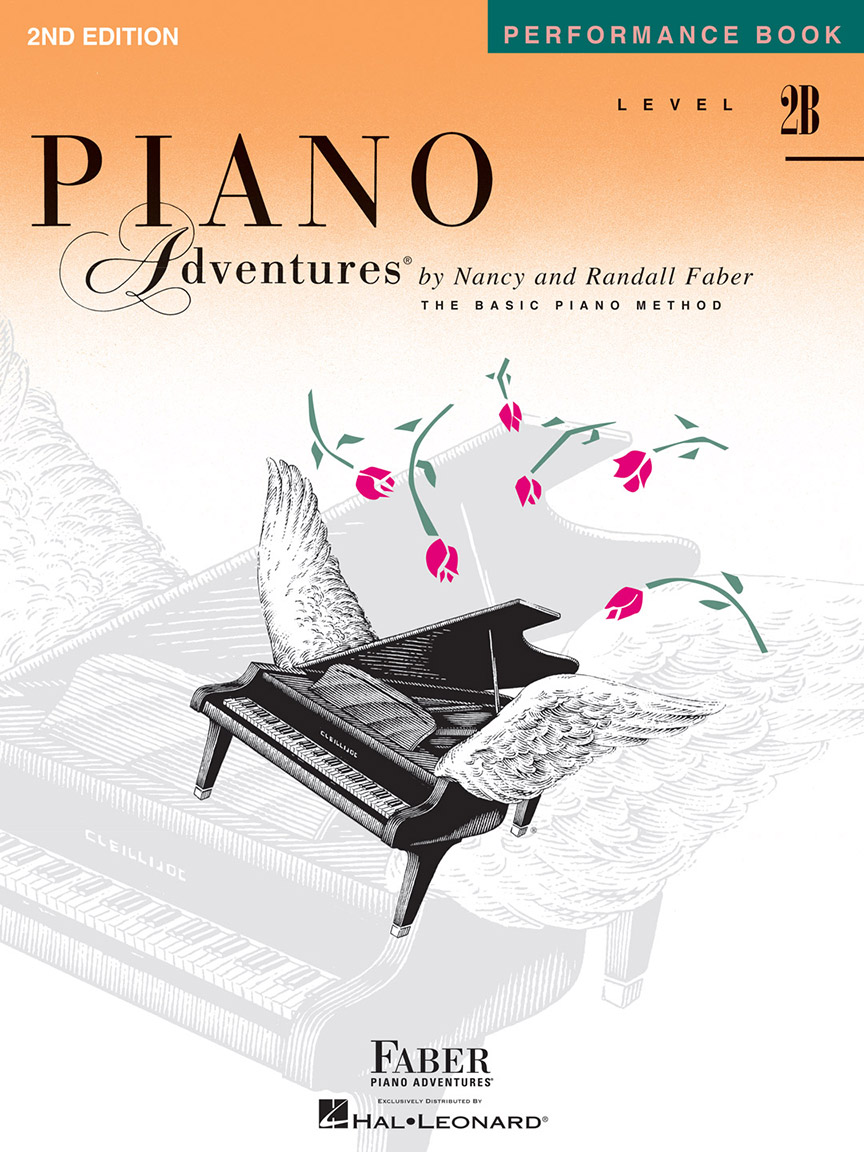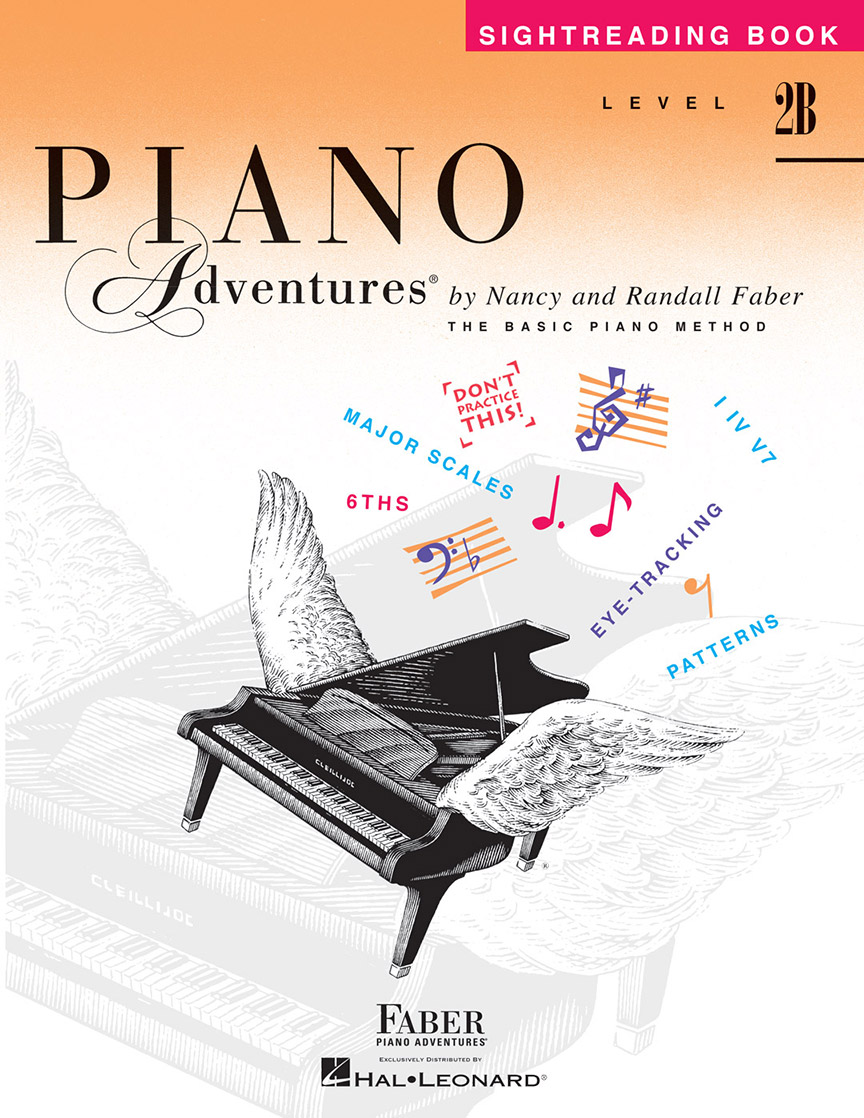
20Questions and Answers for Level 2B
About The Level 2B Books
- The Level 2B Lesson Book starts with a Level 2A Review, “Get Ready for Take-off!” Is this important to do?
- Should I use all four core Level 2B Books: Lesson, Theory, Technique & Artistry, and Performance?
- How do I fit all four core books into a lesson?
- How are outer ledger lines introduced and reinforced? (p. 6)
- How is transposition treated with the major scale and primary chords?
- How is the damper pedal used in Level 2B?
- How is the L.H. developed in Level 2B?
- What are the Technique Secrets and how do they help?
- When should I use the 2B Sightreading Book and how?
About the Level 2B Student
- Are there any student-student duets?
- How should the 2B student count 8th notes?
- What if a student has a poor sense of rhythm?
- How long should a student play “The Ultimate Scale Warm-up” in C, G, and F before moving on?
- How can my students best use the “Scale and Chord Adventures” in the Lesson Book? (pp. 66-71)
- Do 2B students compose, create, and improvise?
- When can a student start playing classical music?
- What pieces could a student play for extra fun?
- Can I teach Level 2B students in an online lesson? What are some teaching tips?
About the Level 2B Adventure Learning Videos
About the Level 2B Audio Files
1. The Level 2B Lesson Book starts with a Level 2A Review, “Get Ready for Take-off!” Is this important to do?
The Level 2A Review that begins Level 2B is a handy teacher assessment tool. Use it for students graduating to Level 2B as well as transfer students. The Level 2A Review helps the teacher assess what is understood and what needs more support.
The two pages cover rhythm, time signatures, note reading, intervals, major and minor 5-finger scales, sharp, flat, tonic, dominant, and many symbols and terms.
Areas in which the student lacks confidence allow the teacher to “review and renew” understanding. Explore board work, flashcards, and cheerful questions and answers to review concepts together. Consider using the 2A Sightreading Book for students who need their reading skills strengthened as they begin Level 2B.
Level 2B Lesson Book
Get Ready for Take-off! (Level 2A Review, pp. 4-5)

2. Should I use all four core Level 2B Books: Lesson, Theory, Technique & Artistry, and Performance?
The four core Level 2B Books form a set for wholistic learning and correlate by page number. The Theory, Technique & Artistry, and Performance Books give fresh perspectives for concepts in the 2B Lesson Book. It is possible a teacher could substitute a different solo book than the Performance Book. However, the precise tie-in of concepts in the core books is hard to beat. The mid-elementary student is forming connections—connections that form the “musical mind”—and the more efficient these connections are made the better.
The core books address things easy to miss in lessons; ear-training, sightreading, improvisation, and importantly, technique from the very first lessons. Taking the time for deeper learning using the four core Level 2B Books prepares students for success in Level 3A.
3. How do I fit all four core books into a lesson?
The three most important books are the Lesson Book, the Theory Book, and the Technique & Artistry Book. A 30-minute lesson allows about 10 minutes per book. A 45-minute lesson, recommended for the 2B student, offers a time advantage for using all four books.
If time is short, consider demonstrating the Performance Book piece while the student watches the music. Give a few pointers, then assign to learn at home as your own “adventure piece.” This gives the teacher an opportunity to see what is easy and what is challenging at the next lesson.
For the Theory Book, the teacher might do the first example on a page with the student, then assign to complete at home. With careful lesson planning and efficient use of lesson time, the four books can be implemented, even if one book is not covered in some lessons.
4. How are outer ledger lines introduced and reinforced? (p. 6)
Unit 1 of the 2B Lesson Book opens with five C’s across the Grand Staff—“The Family of C’s.” The ledger line notes introduced are Low C, two ledger lines below the bass staff and High C, two ledger lines above the treble staff.
Low C and High C expand the landscape of the Grand Staff. Students make graceful gestures outward to these notes. Or, in a faster tempo, explore quick lateral shifts.
Ledger lines C’s appear throughout the level in ostinato passages, cross-hand arpeggios, low pedaled chime sounds, and final accent notes!
Inner ledger notes are introduced mid-way through Level 2B (p. 38). More outer ledger notes are introduced in Level 3A.
Level 2B Lesson Book
The Family of C's (p. 6)

5. How is transposition treated with the major scale and primary chords?
When the student begins transposing outside the 5-finger position, transposition takes on new significance. Using the “ear,” thinking intervals, and relating tonic, dominant, and leading tone all build important theory skills.
An entire song, or just a portion of a piece can be transposed. Students become “keyboard smart” with short transposition workouts.
Level 2B Lesson Book
Captain Hook’s Rockin’ Party (transpose to Gm or Dm, p. 7)

Vive la France (transpose to C, pp. 30-31)

Duke of York Strut (transpose to C, pp. 54-55)

Aria (transpose to G, p. 63)

6. How is the damper pedal used in Level 2B?
Pedaling is used in three ways in the Level 2B Books.
- For the entire piece for a sustained, impressionistic sound.
- For several measures for finesse and a fluid sound.
- For “up-down” connected pedaling with more coordination of the eye, hand, and foot.
Level 2B Lesson Book
Almost Like a Dream (pedal throughout, p. 8)

The Ice Skaters (partial pedal, pp. 26-27)

More About the Damper Pedal (pp. 36-37)

Beach Party (connected pedal, pp. 38-39)

Level 2B Performance Book
Kum Ba Yah (pp. 18-19)

7. How is the L.H. developed in Level 2B?
Left hand development expands at Level 2B with the use of primary chords (I, IV, V7). Pieces include broken chords, L.H. one-octave passages, large L.H. gestures across the C’s, waltz bass, and ostinato patterns.
Level 2B Lesson Book
Sounds from the Gumdrop Factory (L.H. ostinato, p. 9)

The Ice Skaters (L.H. waltz chords, pp. 26-27)

Canoeing in the Moonlight (L.H. broken chords, pp. 56-57)

Auld Lang Syne (L.H. blocked chords, pp. 64-65)

Level 2B Technique & Artistry Book
House of Mirrors (L.H. scale passages, p. 13)

Winter Wind (quick L.H. shifts, pp. 16-17)

Lookout Mountain (lateral L.H. gestures, p. 23)

Level 2B Performance Book
A Day at the Carnival (L.H. melody, pp. 8-9)
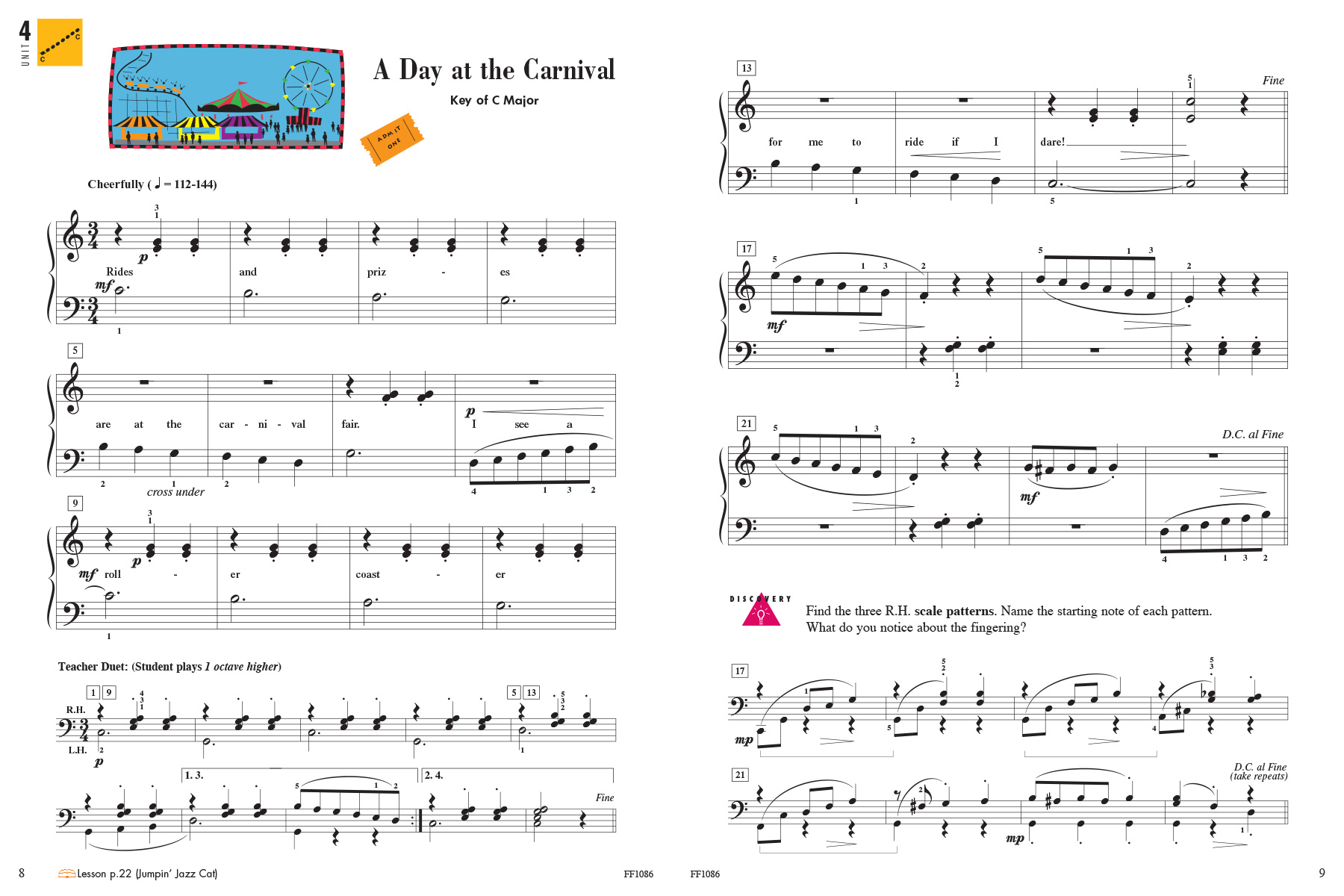
8. What are the Technique Secrets and how do they help?
Technique at the piano requires more than finger muscles. It involves sophisticated body motion between the body, arm, wrist, and finger. We call these motions “technique gestures.”
At each level of Piano Adventures, the student is introduced to level-appropriate Technique Secrets that promote fluent playing while preventing bad habits. These “secrets” are used as daily warm-ups for the exercises that follow in the book. This combination of secrets and exercises leads to an Artistry Magic Piece at the end of each unit. These pieces allow the mid-elementary student to demonstrate artistry based on fine technique learned earlier.
Level 2B Technique & Artistry has 4 Technique Secrets, each with a unique name.
- Arm Weight (Heavy Arms)
- Slur Gesture (Painter’s Brush Stroke)
- Light Thumb (Weightless Thumb)
- Connected Pedaling (Pedal Pushers)
Check out sample videos of Technique Secrets here.

9. When should I use the 2B Sightreading Book and how?
The Level 2B Sightreading Book builds confident readers in two ways: recognition of individual notes and perception of rhythmic and melodic patterns.
The book is organized into sets of 5 exercises, for 5 days of practice. Each set presents variations on a piece from the Level 2B Lesson Book. Play one exercise a day, completing one set per week.
Students may begin the Level 2B Sightreading Book with the first piece in the 2B Lesson Book, “Moon Walker.” Integrating sightreading as the student’s skills expand builds on this important principle: Notes and chords that do not change their location on the staff are integrated into compositional patterns that do change. Permanence and change come together for musical literacy.
Here are several ways to use the Level 2B Sightreading Book.
- Teachers listen to the sightreading example for just “Day 1” at the lesson. Assign the next pages of the 5-day set to sightread at home. At the following lesson, the teacher might choose one sample “Day” from that set to hear. Then assign the next set.
- If teaching 30-minute lessons, teachers might consider using the Sightreading Book in place of the Performance Book.
- Some teachers enjoy using the Sightreading Book at the lesson to introduce a new note or piece. The student then learns the correlating Lesson Book piece at home as an independent study.
- The Sightreading Book can be used as a final end-of-level project. Before starting Level 3A, take several weeks to assign multiple pages of the 2B Sightreading Book, supported with a ChordTime Book. Students can enjoy a change of pace in their practice routine, while celebrating their increasing reading expertise.
Level 2B Sightreading Book
Table of Contents (pp. 2-3)

How to Use (pp. 4-5)

Almost Like a Dream (pp. 10-13)


About the Level 2B Student
10. Are there any student-student duets?
A student-student duet can be found in the 2B Performance Book and the 2B Gold Star Performance Book. (See below.)
For fun, many 2B students may be able to play one of the Teacher Duets from the PreTime Books or PlayTime Books and join with a sibling or younger student in that level.
Level 2B Performance Book
The British Grenadiers (4-hand duet, pp. 28-31)
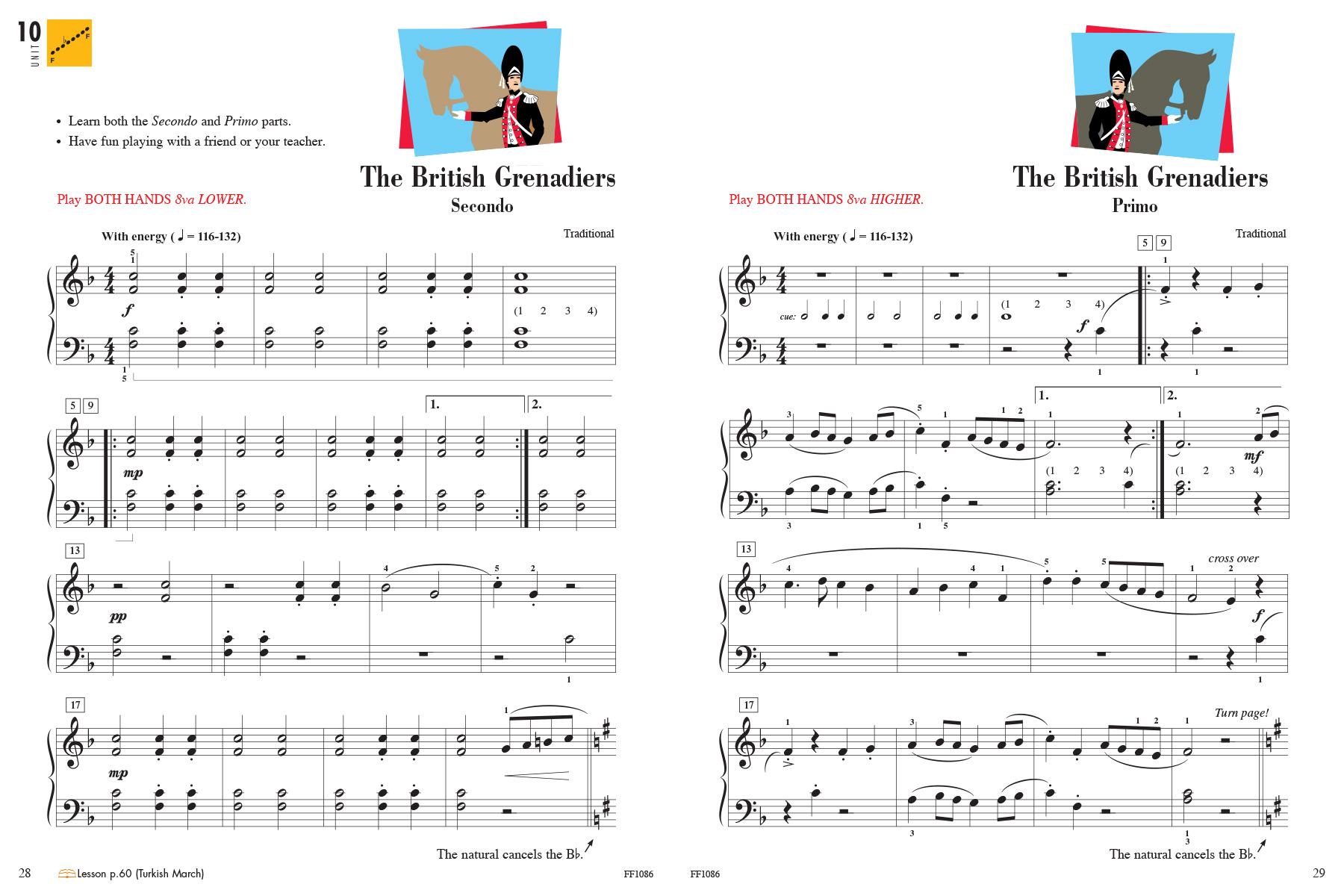

Level 2B Gold Star Performance Book
The Little Tin Soldier (4-hand duet, pp. 18-21)


11. How should the 2B student count 8th notes?
Teachers may use a “combo approach” to count 8th notes at Level 2B. However, metric counting should be increasingly more common for students.
Counting strategies include:
Syllables, such as “ta” for quarter notes and “ti-ti” for two 8th notes. Use occasionally.
Descriptive words, such as “walk” for quarters and “run-ning” for 8ths. Use occasionally.
Numbers for metric counting: 1 + 2 + 3 + 4 +
Now with 8th notes and the dotted quarter note at level 2B, often choose 4-8 measures of a piece to tap and count aloud with the student, subdividing the beat.
“1 + 2 + 3 + 4 +”
The teacher models counting these measures and the student imitates. Or, the student and teacher may tap and count aloud together.
This strategy builds a disciplined, (but not overwhelming) regularity of skill development in metric counting. One need not laboriously count the entire piece aloud. Students can develop fluency with short, focused counting exercises.
12. What if a student has a poor sense of rhythm?
If a student has a poor sense of rhythm, here are fun things to do.
- At Level 2B, many rhythmic errors involve playing accurate 8th-note rhythm patterns and dotted quarter notes. Imitation of the teacher to imprint the “sound pattern” in the student’s ear works wonders.
- Playing the Teacher Duets (when available) lets students enjoy an interesting rhythmic background while demonstrating rhythm independence.
- Most adventurous of all are the orchestrations that give a rhythmic environment to feel the tempo, style, and internal rhythm patterns. Check out a few 2B orchestrations.
Level 2B Lesson Book: sample orchestrations
Sounds from the Gumdrop Factory (p. 9)

Jumpin’ Jazz Cat (pp. 22-23)

I’ve Got Peace Like a River (p. 32)

Turkish March (p. 60)

13. How long should a student play “The Ultimate Scale Warm-up” in C, G, and F before moving on?
“The Ultimate C Scale Warm-up” (p. 21) presents the seven C scales on seven different Cs across the full keyboard range. The L.H. plays the first 3 C scales (ascending and descending). The R.H. continues up the piano with the last 4 C scales—to the highest key!
Practicing the scales in this way not only provides repetition but gives the student a sense of command of the instrument. Here are a few ways the scale might be played.
- Crescendo up and diminuendo down.
- Legato up and staccato down.
- Long-short pattern of swing rhythm.
As students learn the G scale (p. 29), it can be beneficial to play “The Ultimate Scale Warm-up” in both C and G in the lesson. Similarly with the F scale (p. 59).
Begin lessons with scales for focus, review, and a valuable technique check.
Level 2B Lesson Book
The Ultimate C Scale Warm-up (p. 21)

The Ultimate G Scale Warm-up (p. 29)

The Ultimate F Scale Warm-up (p. 59)

14. How can my students best use the “Scale and Chord Adventures” in the Lesson Book? (pp. 66-71)
This 6-page resource section presents all the 12 major and minor 5-finger scales plus a chord warm-up that includes primary chords.
A student could easily begin “Scale and Chord Adventures” in Unit 9 when learning “Lazy Chord Blues” (p. 51). Gradually making their way through the keys will be essential for good musicianship.
A teacher could also consider tackling these as the student arrives at the end of the book, making it a prerequisite for beginning Level 3A. Students might enjoy a ChordTime Piano Book for several weeks while bringing these important theory and technique basics into their fingers.

15. Do 2B students compose, create, and improvise?
There are many opportunities to compose and improvise in Level 2B. These activities are integrated throughout the level and bring support to new concepts.
Level 2B Lesson Book: Students create their own versions of a piece.
Sounds from the Gumdrop Factory (p. 9)

Beach Party (pp. 38-39)

Level 2B Lesson Book: Students create harmony with a lead sheet.
Hey, Ho, Nobody Home Lead Sheet (p. 49)

Level 2B Theory Book: Students improvise using the full major scale.
Let’s Improvise in C Major (p. 11)

Let’s Improvise in F Major (p. 43)

Level 2B Theory Book: Students create melodies and compose an ABA piece.
Complete the Melodies of Famous Composers (p. 13)

Wind in the Grass (ABA form, pp. 28-29)

16. When can a student start playing classical music?
A Level 2B student could begin Preparatory Piano Literature in UNIT 1. The independence of the hands and suggestions for transposition offer a great review while delving into classical music.
Level 2B Theory Book
Let’s Improvise in C Major (p. 11)

Complete the Melodies of Famous Composers (p. 13)

Wind in the Grass (ABA form, pp. 28-29)

17. What pieces could a student play for extra fun?
For extra Level 2B fun, ChordTime Piano Books offer a variety of styles with many familiar songs. The name “ChordTime” suggests exactly that—to play chords!

ChordTime Books support 3 musical outcomes:
- To bring C, G, and F major scales with primary chords into a student’s “toolkit.”
- To recognize I, IV, and V7 blocked chords, broken chords, waltz chord pattern, etc.
- To play these chords with confidence in different musical settings.
The 2B Lesson Book presents I, IV, and V7 chords at these points:
Lazy Chord Blues (key of C primary chords in UNIT 9, p. 51)

Duke of York Strut (key of G primary chords in UNIT 9, pp. 54-55)

Latin Sounds (key of F primary chords in UNIT 10, p. 62)

18. Can I teach Level 2B students in an online lesson? What are some teaching tips?
Yes, it is completely possible to teach Level 2B core books in an online lesson, such as Zoom.
The best way to do this is through subscribing to the Teacher Atlas and using its screen-sharing capability. All books in the Faber Library are available for viewing and screen sharing—including the Level 2A method books and the supplementary ChordTime Piano Books.
Here are some ideas for teaching the Level 2B Lesson Book in an online lesson.
NOTE: Have the student become very familiar with the music before playing. Accomplish this through questions that require active responses from the student. Keep the discussion light, upbeat, and “congratulatory” for answers.
Let’s apply this to the first Unit 1 piece, “Moon Walker.” These are sample ideas. Teachers can create original questions and responses.
Level 2B Lesson Book
Moon Walker (p. 6)

Sample Online Questions for “Moon Walker”
- What’s the title at the top?
“Yes, The Family of C’s.”
- On the Grand Staff below, how many different C’s do you see?
“Correct, five!”
- Say the names of the notes aloud? Start with Low C and go higher.
“Very good.”
- Way back when, Middle C was the very first note you learned on the staff. Will you play that key?
“Good.”
- Now a quick review. Are Bass C and Treble C line or space notes?
“Yes, both are space notes.”
- Treble C is the 3rd space up, Bass C is the 3rd space down. Will you play Bass C? And now Treble C?
“Good.”
- Two notes to go—Low C and High C. Notice one is below the staff and one is above the staff, on short little lines! These short lines are called ledger lines. Can you say the term “ledger line”?
“That’s right.”
- Can you spell the word “ledger” looking at the first sentence?
“Great!”
- (Optional) With a pencil, can you trace over the two ledger lines for Low C and then High C? When you’re done, show me your work on the screen.
“Excellent!”
- Let’s look at the notes for “Moon Walker.” The 5 C’s make a big swoop up, and a big swoop down. Can you see a symbol added to each note? What do we call that?
“Yes, an accent mark.”
- Now look at the fingering Which finger is used for the entire piece?
“Yes, finger 3!”
- Does this piece use the pedal?
“Yes, for the entire piece!”
- Now look at the illustration. If someone were walking on the moon, they’d make slow, graceful leaps. I’m going to play and make some slow, graceful lifts— from C to C. Watch my hand motion.
(Play, naming the notes aloud, “Low C, Bass C, Middle C” etc.)
“Your turn! Pedal down. Drop into each key, forte, with arm weight.”
- Here’s a few Super Student questions.
How many measures are in the piece? “Yes, 5.”
Which measure has only Low Ledger Line C? “Right, m. 5.”
Which measure has High Ledger Line C down to Treble C? “Yes, m. 3.”
How about Low Cup to Bass C? “Yes, m. 1.”
- To end, let’s try the Discovery question. Can you play “Moon Walker” using only D’s across the keyboard?
“Very good. As you play “Moon Walker” this week, also transpose to D keys. Great work on this piece!”
About the Level 2B Adventure Learning Videos
19. What are the Adventure Learning Videos?
These videos feature close-ups of the hands with simple text that taps the student’s “musical mind” with theory analysis and technique tips.
The Adventure Learning Videos for Level 2B are currently in progress and should be completed at the end of 2022. They can be very useful in a variety of ways and are modeled after the Primer Adventure Learning Videos.
About the Level 2B Audio Files
20. What are the audio files and how should I use them?
Orchestrated accompaniments for Level 4 pieces are available in the Audio Cloud and Piano Adventures Player app. Have fun exploring with your students!
Preview a track a week before teaching it at the lesson. As you listen together, discuss the sound. Is the piece happy or sad? Is the tempo fast or slow? Can you name one of the instruments that is playing?
Playing with a background accompaniment demands correct rhythm, and can be more fun than using a metronome. Students learn to feel the meter and understand the need to “keep going.” Demonstrate with the practice tempo track and point to each note in time, or chant the lyrics, finger numbers, or note names.
Many of the accompaniments encourage free improvisation on the black or white keys. These extra measures offer opportunities to create original sounds.
The musical vignettes in this series introduce the student to a variety of musical sounds and ensembles, such as the marching band, chamber orchestra, jazz ensemble, rock band, and more.


